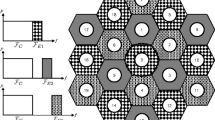Abstract
In the OFDMA-based downlink of wireless cellular communication networks, the intercell interference would be a key performance-limiting factor, especially for the cell edge users. To enhance the cell edge user performance, several flexible power allocation schemes have been proposed, e.g., the so-called soft frequency reuse scheme and the partial frequency reuse scheme. This paper analyzes those schemes in a very realistic multicell setting, investigates the layer 2 resource allocation algorithms that are associated to the physical layer setting, and finally gives results of the performance evaluation.










Similar content being viewed by others
References
3GPP TS 36.300 V8.0.0, E-UTRA and E-UTRAN overall description, stage 2
Jorguseski L, Prasad R (2007) Downlink resource allocation in beyond 3G OFDMA cellular systems. In: PIMRC 2007, Athens, Greece, September 2007
Huawei (2005) Soft frequency reuse scheme for UTRAN LTE. In: 3GPP R1-050507, TSG RAN WG1 Meeting #41, Athens, Greece, May 2005
Sternad M, Ottosson T, Ahlen A, Svensson A (2003) Attaining both coverage and high spectral efficiency with adaptive OFDM downlinks. In: IEEE vehicular technology conference VTC2003-Fall, Orlando, FL, October 2003
Xiang Y, Luo J, Hartmann C (2007) Inter-cell interference mitigation through flexible resource reuse in OFDMA based communication networks. In: European wireless 2007, Paris, April 2007
3GPP, Physical layer aspects for evolved Universal Terrestrial Radio Access (UTRA) (Release 7). TR 25.814 V7.0.0 (2006-06)
Kelly F, Maulloo A, Tan D (1998) Rate control in communication networks: shadow prices, proportional fairness and stability. J Oper Res Soc 49:237–252
Song G, Li YG (2005) Cross-layer optimization for OFDM wireless network part II: algorithm development. IEEE Trans Wirel Commun 4:625–634 (March)
Yang X (2002) Designing traffic profiles for bursty internet traffic. In: Proceedings of IEEE global internet, Taipei, Taiwan, 17–21 November 2002
ETSI, Selection procedures for the choice of radio transmission technologies of the UMTS (UMTS 30.03 version 3.2.0). TR 101 112 V3.2.0 (1998-04)
Author information
Authors and Affiliations
Corresponding author
Rights and permissions
About this article
Cite this article
Xiang, Y., Luo, J., Schulz, E. et al. Performance impact of flexible power arrangement in OFDMA based cellular communication networks. Ann. Telecommun. 63, 271–280 (2008). https://doi.org/10.1007/s12243-008-0033-6
Received:
Accepted:
Published:
Issue Date:
DOI: https://doi.org/10.1007/s12243-008-0033-6





